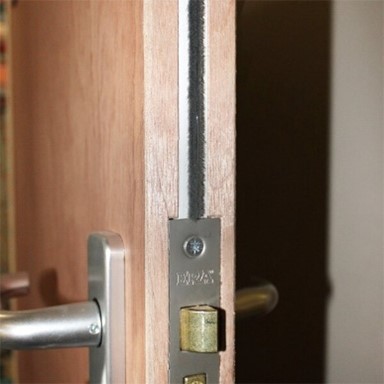
Fire doors play a crucial role in protecting buildings and the people inside them from the spread of fire. They are designed to slow down the spread of smoke and fire, enabling occupants adequate time to evacuate the building safely and emergency services more time to respond. Unlike regular doors, fire doors are manufactured to withstand high temperatures, whilst minimising the potentially hazardous physical effects of the fire. They are typically made from materials such as steel or solid-core wood and are made to resist the effects of fire for a specific period of time. This time period – known as the fire resistance rating – is measured in minutes and is determined by testing the door under controlled conditions. The most common fire resistance ratings for fire doors are 20 minutes and 45 minutes. Fire-rated doors are usually found in offices, hotels, warehouses, and other commercial buildings.
Different types of fire doors
There are many types of fire doors available, each with specific features and capabilities. Some of these common types include:
- Single action fire doors – These doors are designed to swing in one direction only, typically used in corridors or stairwells where there is a high risk of smoke and fire spread.
- Double action fire doors – These doors are designed to swing in both directions, usually used in areas where there is a high volume of foot traffic.
- Fire-rated glazed doors – These doors have fire-resistant glass panels that allow light to pass through while still providing protection from the smoke and fire.
- Fire and smoke curtains – These doors are specially designed with curtains that can be installed in openings that are not able to accommodate a fire door.
- FD30 and FD60 fire doors – The main difference between FD30 fire doors and FD60 fire doors, is the time in which it will take for a fire to eventually break past the door itself. FD30 initially means the door is built to withstand a fire for a solid 30 minutes. Similarly, FD60 fire doors are able to prevent a fire from spreading for 60 minutes. Depending on the size and layout of the building, one type of fire door may be more suitable than another and the price will differ depending on the fire rating. Additionally, if an ‘s’ appears after FD30 or FD60, then this signifies that not only are these doors able to help prevent a fire from spreading, but it can also stop the spreading of cold smoke. This is done through the smoke brushes, as well as intumescent strips on the door.

What are Intumescent Strips and how do they work?
The weakest point of a fire door is the gap between the door and the frame, this is where a piece of fire-resistant material called intumescent strips are fitted. This makes these seals essential to the functionality of a fire door, as when they are exposed to heat, they will expand, closing any gaps between the door and the frame that may allow fire to pass through. This then reduces the spread of fire and smoke for up to 60 minutes, depending on the type of fire door specification you have.
All fire doors require intumescent strips and there are two different types that you can have – fire only or fire and smoke.
Fire only seals will prevent the spread of fire only. As mentioned above, the seal will expand when exposed to heat which will then close any gaps in the door that the fire can escape through. Most of the time, a certain amount of smoke will still be able to escape through, although not as much as it would do without a fire door.
Fire and smoke intumescent strips protect against the spreading of both fire and smoke. Similarly to fire-only seals, they expand when exposed to a certain degree of heat, but will sometimes come with a brush or a flipper. These added features will prevent any toxic smoke from spreading and entering the rest of the building, reducing the risk of damage or injury to the people inside.
We are BRE academy trained and are CPD qualified in Fire Door Safety.
